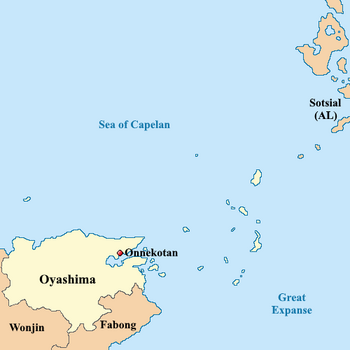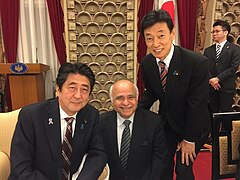Oyashima: Difference between revisions
m (→Economy) Tag: 2017 source edit |
m (→Demographics) Tag: 2017 source edit |
||
| (9 intermediate revisions by the same user not shown) | |||
| Line 39: | Line 39: | ||
|government_type = Elective Federal Constitutional Monarchy | |government_type = Elective Federal Constitutional Monarchy | ||
|leader_title1 = Lord of Lords (Omo no Ryōshu/主の領主) | |leader_title1 = Lord of Lords (Omo no Ryōshu/主の領主) | ||
|leader_name1 = | |leader_name1 = Koshamain Itakshir | ||
|leader_title2 = | |leader_title2 = | ||
|leader_name2 = | |leader_name2 = | ||
| Line 62: | Line 62: | ||
|population_estimate_rank = | |population_estimate_rank = | ||
|population_estimate_year = | |population_estimate_year = | ||
|population_census = | |population_census = 37,435,619 | ||
|population_census_year = [[2030]] | |population_census_year = [[2030]] | ||
|population_density_km2 = | |population_density_km2 = 75.564 | ||
|population_density_sq_mi = | |population_density_sq_mi = 195.711 | ||
|population_density_rank = | |population_density_rank = | ||
|GDP_nominal = $ | |GDP_nominal = $1,178,959,949,167 <br><small>$1.178 trillion</small> | ||
|GDP_nominal_per_capita = $ | |GDP_nominal_per_capita = $31,493 | ||
|Gini = 57.4 | |Gini = 57.4 | ||
|Gini_rank = | |Gini_rank = | ||
| Line 110: | Line 110: | ||
The people of Oyashima are predominantly culturally {{wp|Ainu people|Oyashi}} (with large minorities of {{wp|Japanese people|Mutsutorine}}, {{wp|Vietnamese people|Danehonger}}s), speak {{wp|Ainu language|Oyash}}, and most practice {{wpl|Shinto}}. | The people of Oyashima are predominantly culturally {{wp|Ainu people|Oyashi}} (with large minorities of {{wp|Japanese people|Mutsutorine}}, {{wp|Vietnamese people|Danehonger}}s), speak {{wp|Ainu language|Oyash}}, and most practice {{wpl|Shinto}}. | ||
==Demographics== | |||
{{Pie chart | |||
| radius = 100 | |||
| thumb =right | |||
| caption = Self-reported ethnic origin in Tapakdore (2030) | |||
| other = | |||
| label1 = {{wp|Ainu people|Oyashi}} | |||
| value1 =40.3 | |||
| color1 =#4F7942 | |||
| label2 = {{wp|Japanese people|Mutsutorine}} | |||
| value2 =21.5 | |||
| color2 =#8FBC8F | |||
| label3 = {{wp|Vietnamese people|Danehonger}} | |||
| value3 =20.2 | |||
| color3 =#9FA91F | |||
| label4 = [[Occidental]] | |||
| value4 =2.8 | |||
| color4 =#960018 | |||
| label5 = other/multi-ethnic | |||
| value5 =15.2 | |||
| color5 =Blue | |||
}} | |||
<gallery mode="packed"> | |||
File:Khảo sát ý kiến khách hàng.jpg|Danehongers | |||
File:Unseen_Vietnam_(30450184301).jpg|Danehong woman | |||
File:20220108_mizuno-itsumi.jpg|Mutsutorine woman | |||
File:Dancing girl of Izu, where is your drum?.jpg|Mutsutorine woman in traditional dress | |||
File:Clamp at Anime Expo 2006 (cropped).jpg|Group of Mutsutorine women | |||
File:Watanabe Daichi from "Gangoose" at Opening Ceremony of the Tokyo International Film Festival 2018 (30677697607).jpg|Young Mutsutorine man | |||
File:Japanese Astronomer Inoue Makoto.JPG|Older Mutsutorine man | |||
File:Ryuko Hira with Prime Minister of Japan H.E. Shinzo Abe and Minister of Economy, Trade, and Industry of Japan H.E. Yasutoshi Nishimura.jpg|Mutsutorine politicians | |||
File:Woman_playing_traditional_Ainu_instrument.jpg|Oyashi woman in traditional dress | |||
File:Fight_over_a_soft-serve_ice_cream!_(31888849323).jpg|Oyashi family | |||
File:US_Marine_Corps_photo_170825-M-NP551-0295_U.S._Marines_greet_Japanese_Ground_Self-Defense_Force.jpg|Oyashi and Burgoignesc soldiers | |||
</gallery> | |||
==Geography== | ==Geography== | ||
| Line 121: | Line 158: | ||
==History== | ==History== | ||
==Economy== | ==Economy== | ||
[[File:Endless_Cityscape_of_Tokyo_(51984496650).jpg|250px|right]] | |||
Oyashima is a {{wp|mixed economy}} {{wp|developed country}} with a {{wp|World Bank high-income economy|high-income economy}} and is the one of the most industrialized countries in [[Audonia]], behind only [[Daxia]]. Oyashimane brands are internationally famous and garnered Oyashima's reputation for its quality electronics, ship building, automobiles, armaments, and other manufactured goods. Oyashima is also considered a hospitable tropical paradise with tourism making up 6.2% of the nation's GDP. | |||
Its massive investment in education has taken the country from mass illiteracy to a major international technological powerhouse since the 1980s. This occured as a result of massive [[Burgundie|Burgoignesc]] financial and cultural investment during and after [[Operation Kipling]]. The country's national economy benefits from a young and highly skilled workforce and is among the most educated countries in the world with one of the highest percentages of its citizens holding a tertiary education degree. | |||
Oyashima's economy was one of the world's fastest-growing from the early 1960s to the late 1990s and was still one of the fastest-growing developed countries in the 2000s. | |||
The Oyashimane economy is heavily dependent on international trade, and the country has one of the world's largest foreign-exchange reserves. | |||
Major sectors include shipbuilding and repair, automotive manufacturing, electronics manufacturing, armaments manufacturing, tourism, mining, and construction. Agriculture is present in Oyashima but it is not a primary contributor to the national economy. Throughout its history, especially during | |||
===Manufacturing=== | |||
====Shipbuilding and repair==== | |||
[[File:Aerial_View_of_Daewoo_Shipbuilding_&_Marine_Engineering.jpg|250px|right]] | |||
====Automobiles==== | |||
====Electronics==== | |||
====Armaments==== | |||
===Tourism=== | |||
[[File:Approaching_paradise.jpg|250px|right]] | |||
Tourism is an important sector for the Oyashimane economy. The travel and tourism industry contributed 6.2% to the country's GDP in [[2032]]. Coastal tourism, encompassing beach and diving activities, constitutes 25% of the Oyashima's tourism revenue, serving as its primary income source in the sector. As of [[2032]], 5.23 million Oyashimane were employed in the tourism industry and as of September [[2033]], Oyashima generated $5.5 billion in revenue from tourists, coming mostly from [[Burgundie]], [[Arcerion]], and [[Tierrador]]. The country attracts an average of 8,360,682 foreign visitors a year. In [[2029]], foreign arrivals peaked at 12,260,913. Popular activities include: beaching and diving, hiking, biodiversity research and education, arts and crafts tourism, festivals, and eastern medical tourism. | |||
The most popular destinations are the white sand beaches of the northern coast and the island for local and foreign visitors. The western plateau on the mainland has become a popular hiking destination. The plateau has a wide range of flora and fauna, including over 272 bird species, 111 of which are endemic to the area. | |||
===Mining and mineral extraction=== | |||
===Construction=== | |||
===Infrastructure=== | ===Infrastructure=== | ||
====Rail==== | ====Rail==== | ||
Oyashima uses [[Track gauges around the world|Standard gauge]], 1,435 mm (4 ft 8+1⁄2 in) as most of its rail infrastructure has been under the auspices of [[Burgundie]] and its sphere of influence in the [[ | Oyashima uses [[Track gauges around the world|Standard gauge]], 1,435 mm (4 ft 8+1⁄2 in) as most of its rail infrastructure has been under the auspices of [[Burgundie]] and its sphere of influence in the [[Audonia]], who all use that rail gauge. | ||
====Roads==== | ====Roads==== | ||
Revision as of 23:16, 28 March 2024
| This article is a stub. You can help IxWiki by expanding it. |
State of Oyashima Oyashima Kokka (国家 むつとり) | |
|---|---|
Anthem: A Hundred Isles | |
 Map of Oyashima | |
| Capital | Onnekotan |
| Official languages | Oyash |
| Recognised regional languages | Mutsutori, Danehonger |
| Ethnic groups | Oyashi, Mutsutorine, Danehonger |
| Religion | Shinto, Confucianism, Mercantile Reform Protestantism |
| Demonym(s) | Oyashimane |
| Government | Elective Federal Constitutional Monarchy |
• Lord of Lords (Omo no Ryōshu/主の領主) | Koshamain Itakshir |
| Legislature | Assembly of Lords (Omo no shūkai/主の集会) |
| Area | |
• | 495,412.926 km2 (191,280.000 sq mi) |
| Population | |
• 2030 census | 37,435,619 |
• Density | 75.564/km2 (195.7/sq mi) |
| GDP (nominal) | estimate |
• Total | $1,178,959,949,167 $1.178 trillion |
• Per capita | $31,493 |
| Gini (2020) | 57.4 high |
| HDI (2024) | 0.691 medium |
| Currency | Yun (¥) |
| Time zone | UTC0 (time zone) |
• Summer (DST) | UTC+0 |
| Date format | dd-mm-yy |
| Driving side | right side |
| Calling code | 6-(860) |
| ISO 3166 code' | MU |
Oyashima is an industrialized and modern nation in northeastern Audonia, in the Dolong region. It is at the confluence of the Sea of Capelan and the Great Expanse. It is bordered in the southwest by Danehong, Metzetta in the southeast, and shares a maritime border with the Alstinian islands of Sotsial.
Oyashima is a elective federal constitutional monarchy. It has a unicameral legislature called the Assembly of Lords, a supreme court, and an executive, the Lord of Lords, the elected monarch.
It is a member of the League of Nations, the International Red Cross and Red Crescent Movement, and many other international organizations.
It has a strong market economy focused on exports, in collaboration with Burgundie whose companies have a stake in many of the country's export and shipping activities.
Many scholars have criticized its economic governance and politics, arguing that it is merely a client of the Burgoignesc thalattocracy's economic and cultural might.
The people of Oyashima are predominantly culturally Oyashi (with large minorities of Mutsutorine, Danehongers), speak Oyash, and most practice Shinto.
Demographics
Self-reported ethnic origin in Tapakdore (2030)
-
Danehongers
-
Danehong woman
-
Mutsutorine woman
-
Mutsutorine woman in traditional dress
-
Group of Mutsutorine women
-
Young Mutsutorine man
-
Older Mutsutorine man
-
Mutsutorine politicians
-
Oyashi woman in traditional dress
-
Oyashi family
-
Oyashi and Burgoignesc soldiers
Geography
Northern most point: 15.710N, Southern most point: 7.174N
Climate
- Climate_of_the_Philippines
- tropical wet
History
Economy

Oyashima is a mixed economy developed country with a high-income economy and is the one of the most industrialized countries in Audonia, behind only Daxia. Oyashimane brands are internationally famous and garnered Oyashima's reputation for its quality electronics, ship building, automobiles, armaments, and other manufactured goods. Oyashima is also considered a hospitable tropical paradise with tourism making up 6.2% of the nation's GDP. Its massive investment in education has taken the country from mass illiteracy to a major international technological powerhouse since the 1980s. This occured as a result of massive Burgoignesc financial and cultural investment during and after Operation Kipling. The country's national economy benefits from a young and highly skilled workforce and is among the most educated countries in the world with one of the highest percentages of its citizens holding a tertiary education degree. Oyashima's economy was one of the world's fastest-growing from the early 1960s to the late 1990s and was still one of the fastest-growing developed countries in the 2000s. The Oyashimane economy is heavily dependent on international trade, and the country has one of the world's largest foreign-exchange reserves. Major sectors include shipbuilding and repair, automotive manufacturing, electronics manufacturing, armaments manufacturing, tourism, mining, and construction. Agriculture is present in Oyashima but it is not a primary contributor to the national economy. Throughout its history, especially during
Manufacturing
Shipbuilding and repair

Automobiles
Electronics
Armaments
Tourism

Tourism is an important sector for the Oyashimane economy. The travel and tourism industry contributed 6.2% to the country's GDP in 2032. Coastal tourism, encompassing beach and diving activities, constitutes 25% of the Oyashima's tourism revenue, serving as its primary income source in the sector. As of 2032, 5.23 million Oyashimane were employed in the tourism industry and as of September 2033, Oyashima generated $5.5 billion in revenue from tourists, coming mostly from Burgundie, Arcerion, and Tierrador. The country attracts an average of 8,360,682 foreign visitors a year. In 2029, foreign arrivals peaked at 12,260,913. Popular activities include: beaching and diving, hiking, biodiversity research and education, arts and crafts tourism, festivals, and eastern medical tourism. The most popular destinations are the white sand beaches of the northern coast and the island for local and foreign visitors. The western plateau on the mainland has become a popular hiking destination. The plateau has a wide range of flora and fauna, including over 272 bird species, 111 of which are endemic to the area.
Mining and mineral extraction
Construction
Infrastructure
Rail
Oyashima uses Standard gauge, 1,435 mm (4 ft 8+1⁄2 in) as most of its rail infrastructure has been under the auspices of Burgundie and its sphere of influence in the Audonia, who all use that rail gauge.










